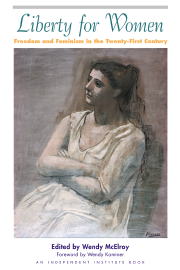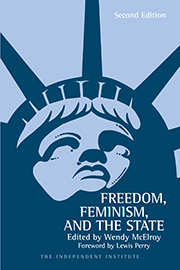History frowns upon the belief that government protects children’s rights, and yet that is precisely the claim that undergirds child labor laws, now enforced in most parts of the world. Hardly anyone dares question their existence, much less the conventional history of child labor, no matter how many children and families continue to be victimized by government regulation of labor.
Consider child labor in nineteenth-century Britain—the wellspring from which modern child labor laws evolved. Immediately, hideous snapshots flash in the mind: five-year-olds being lowered into coal mines, wan children at textile mills, a Dickenesque Oliver asking for “more.” These images are used to condemn the free market and the Industrial Revolution against whose evils a humanitarian government is said to have passed child labor laws. This analysis is badly mistaken.
For one thing, it misses a key distinction. Early-nineteenth-century Britain had two forms of child labor: free, and, parish or “pauper” children. Historians J.L. and Barbara Hammond, whose work on the British Industrial Revolution and child labor is considered definitive, recognized this distinction [The Village Labourer: 1760-1832: A Study in the Government of England Before the Reform Bill]. The free-market economist Lawrence W. Reed, in his essay, “Child Labor and the British Industrial Revolution,” goes one step farther in recognizing the importance of the distinction.
Free-labor children lived with their parents or guardians and worked during the day at wages agreeable to those adults. But parents often refused to send their children into unusually harsh or dangerous work situations. As Reed notes, “Private factory owners could not forcibly subjugate ‘free-labour’ children; they could not compel them to work in conditions their parents found unacceptable.”
For example, the unacceptable position of “scavenger” in textile factories. Typically, scavengers were young children—about six years old—who had to salvage loose cotton from under the machinery. Because the machinery was running, the job was dangerous and injury was common.
Fortunately for businessmen willing to use the State to their advantage, government had no qualms about sending parish children to work under running machines. Parish children were under the direct authority of government officials. Parish workhouses had existed for centuries, but sympathy for the downtrodden was also lessened by the fact that taxes for poor relief in 1832 were over five times higher than they had been in 1760. Gertrude Himmelfarb’s book, The Idea of Poverty, chronicles this shift in attitude toward the poor from compassion to condemnation.
In 1832, partly at the behest of labor-hungry manufacturers, the Royal Poor Law Commission began an inquiry into the “the practical operation of the laws for the relief of the poor.” Its report divided the poor into two basic categories: lazy paupers who received governmental aid; and, the industrious working poor who were self-supporting. The result was the Poor Law of 1834, which statesman Benjamin Disraeli called an announcement that “poverty is a crime.”
The Poor Law replaced outdoor relief (subsidies and handouts) with “poor houses” in which pauper children were virtually imprisoned. There, the conditions were made purposely harsh to discourage people from applying. Virtually every parish in Britain had abandoned workhouse children who, being bought and sold to factories, experienced the deepest horrors of child labor. In this, the workhouses were merely continuing a practice common before the Poor Laws.
It is no coincidence that the first industrial novel published in Britain was Life and Adventures of Michael Armstrong: Factory Boy, by Frances Trollope. Michael was apprenticed to an agency for pauper children. Nor is it coincidence that “Oliver Twist” was not abused by his parents, but by brutal workhouse officials in comparison to whom Fagin was a humanitarian. And, remember, at the age of twelve with his family in debtor’s prison, Dickens himself was a pauper child who slaved at the Blacking Factory. Reed observes, the “first Act in Britain that applied to factory children was passed to protect these very parish apprentices, not ‘free-labor’ children.” The Act was explicit in doing so.
Thus, in advocating the regulation of child labor, social reformers asked government to remedy abuses for which it was largely responsible. Once more, government was “a disease masquerading as its own cure.” To their credit, some reformers realized that regulations to help the poor did precisely the opposite.
But what of the other side of the equation—the businessmen willing to use pauper children as slave labor? Consider one example. To assuage labor shortages at his textile mills, Samuel Greg took children from workhouses. Indeed, children were offered to him. In February 1817, the Vicar of Biddulph wrote to him: “The thought has occurred to me that some of the younger branches of the poor of this parish might be useful to you as apprentices in your factory at Quarry Bank. If you are in want of any of the above, we could readily furnish you with 10 or more at from 9 to 12 years of age of both sexes.” Usually, such children were apprenticed to an employer until the age of twenty-one.
When the local parishes no longer provided sufficient labor, Greg went as far as Liverpool and London for children. Some parishes paid businessmen like Greg between two and four pounds to take a child off their hands. The children received their board and lodging from Greg, as well as a small salary.
Greg saw himself as a humanitarian and, by contrast with workhouse officials, he probably was. In The Philosophy of Manufactures (1835), Andrew Ure wrote: “At . . . the great firm of Greg and Son . . . stands a handsome house, two stories high, built for the accommodation of the female apprentices. They are well fed, clothed and educated. The apprentices have milk-porridge for breakfast, potatoes and bacon for dinner, and meat on Sundays.”
But no amount of decent treatment can obscure the fact that the children were stripped of the one thing they possessed—their labor and the right to contract. Nothing can convert the violation of their rights as laborers into an act of benevolence by Greg or by government officials.
The only real protections children can enjoy are the family structure and their ability to be self-sufficient. In an ideal world—a Western world families—are prosperous and supportive: children are protected and educated. In Third World countries, parents often cannot provide the basics of life for their children, who must trade their labor for sustenance. The greatest act of benevolence is to recognize their right to contract and to work in the same manner as adult rights are respected. Anything that interferes with the self-sufficiency necessary for their survival is child abuse.









